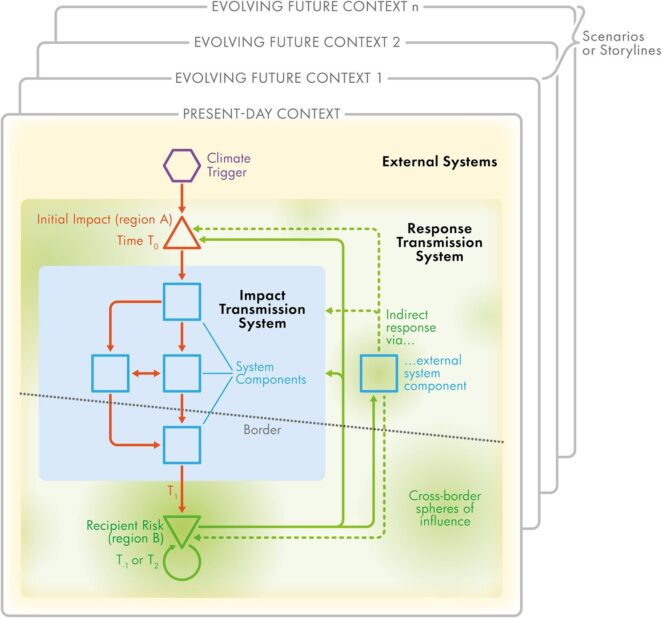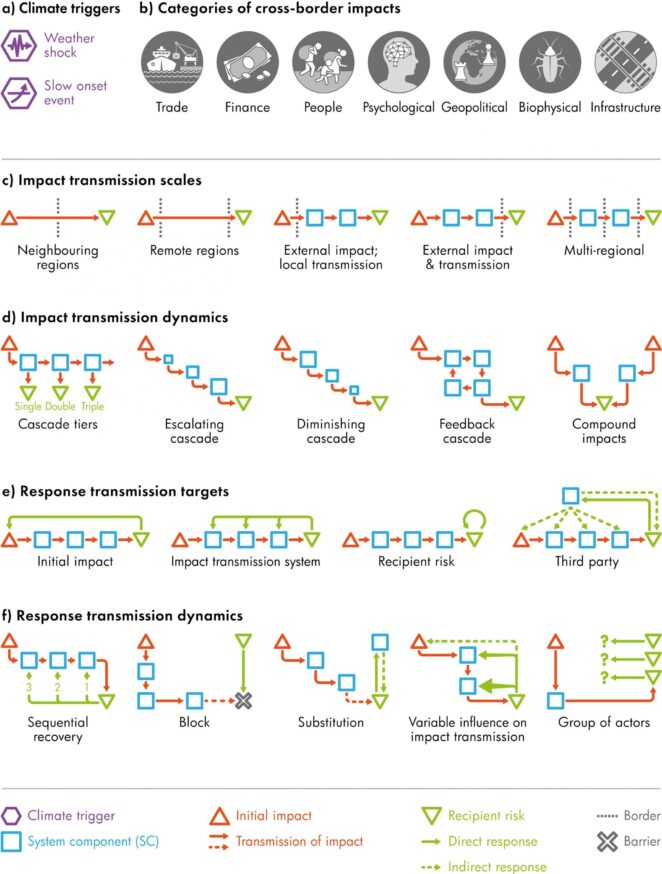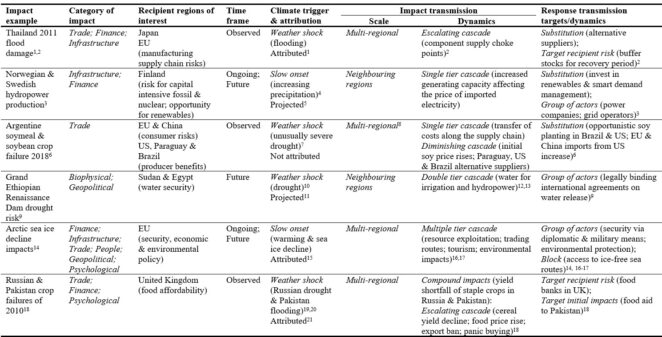CASCADES’ Conceptual Framework of cascading climate impacts

Introduction
Climate change impacts, adaptation and vulnerability studies tend to confine their attention to impacts and responses within the same geographical region. However, this approach ignores cross-border climate change impacts that occur remotely from the location of their initial impact and that may severely disrupt societies and livelihoods.
The new conceptual framework and accompanying nomenclature developed by CASCADES help describe and analyse these transboundary climate impacts and inform adaptation policies.
CASCADES is a project supported by the European Commission which identifies how the risks of climate change to countries, economies and peoples beyond Europe might cascade into Europe. It does so by analysing how these risks interact with major challenges facing European societies.
*A summary of the paper and a presentation of the conceptual framework by Professor Tim Carter can be found below. Download the full publication from the right-hand column for more details.
Framing cross-border impacts and responses
The framework focuses on how a climate impact occurring at a given location may be transmitted across borders, potentially presenting a risk to a region of interest that is remote from the initial impact, which may require a response from actors in that region. It includes several elements, illustrated in the figure below (see Fig. 2 in the paper).
An initial impact in one region due to a climate trigger is propagated (red arrows) via an impact transmission system (blue area) comprising impacts on interconnected system components of varied complexity, resulting in a recipient risk in a second region (location of the border is notional). Adaptive responses for ameliorating that risk (green arrows) can be targeted within a response transmission system (green area) directly at the recipient risk itself, at the impact transmission system and at the site of initial impact (solid arrows), and indirectly via system components external to the impact transmission system (dashed arrows).

Typology of cross-border impacts and response
It can be helpful to characterise the separate elements of the framework and their assumed causal relationships for assisting in the deployment of suitable methods of assessment. Many of these elements are depicted in the figure below (Fig. 3 in the paper), which can be thought of as a toolbox from which components are selected according to a case in question, and inserted in the relevant part of the conceptual framework. However, it should also be understood that given the numerous variants and complexities of cross-border impacts, the examples shown in the figure are intended to be indicative and are by no means exhaustive.

Operationalising the framework
The paper presents a provisional operationalisation below via a set of six contrasting examples, which are summarised in the table below (Table 1 in the paper).

Various challenges need to be overcome when operationalising the conceptual framework. These include the lack of specific scientific studies that describe in detail the links between different system components. The difficulty of separating a climate cause from many other potential triggers of impacts and their transmission (e.g., economic, political, environmental or health-related triggers) is another formidable challenge. Defining system boundaries for each case can also present challenges.
Discussion
This section discusses the reasons why a conceptual framework describing cascading, cross-border climate change impacts is considered necessary and useful and how the framework introduced above contributes to this objective.
The advantages of a detailed and comprehensive framework are fourfold:
- Provide a common language with which to identify and assess cross-border impacts
- Contribute to enhancing our understanding of those impacts by providing structure and clarity
- Facilitate comparisons between studies on diverse aspects of cross-border impacts
- Inform policy to reduce the risks such impacts pose to society
The framework presented above is research-oriented more than it is user-oriented. Its focus on climate change triggers means that it emphasises the origins of cross-border impacts at the expense of other categories of risk or risk ownership. A climate focus also has the danger of downplaying other risks (e.g., triggered by political, economic, geophysical or health circumstances) whose solutions may share many features of those advocated to address climate risks.
The framework is also likely to be incomplete in its coverage of specific mechanisms and typologies of impact and response dynamics, as well as of scales and response targets. Another limitation of this framework is that it focuses in its current form more on impact transmission than response transmission.
Conclusion
The conceptual framework presented here provides a simple, but flexible, structure to describe and analyse cross-border climate impacts and their consequences. It offers a foundation for consistent comparisons of different patterns of cross-border impacts in different sectors and geographies. It can also be used to inform adaptation planning. The framework can help in the identification of subtle dynamics that may guide new empirical research and data collection as well as model development.
Presentation of the CASCADES conceptual framework
In the video below, Professor Tim Carter (Finnish Environment Institute, SYKE)explains the elements of the framework and offers some illustrations of its possible application.
Suggested citation
Carter, T. R., Benzie, M., Campiglio, E., Carlsen, H., Fronzek, S., Hildén, M., Reyer, C. P. O., & West, C. (2021). A conceptual framework for cross-border impacts of climate change. Global Environmental Change, 69, 102307. https://doi.org/10.1016/j.gloenvcha.2021.102307
(0) Comments
There is no content